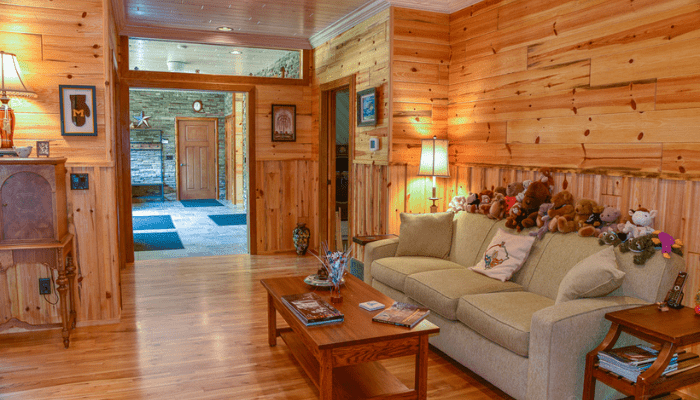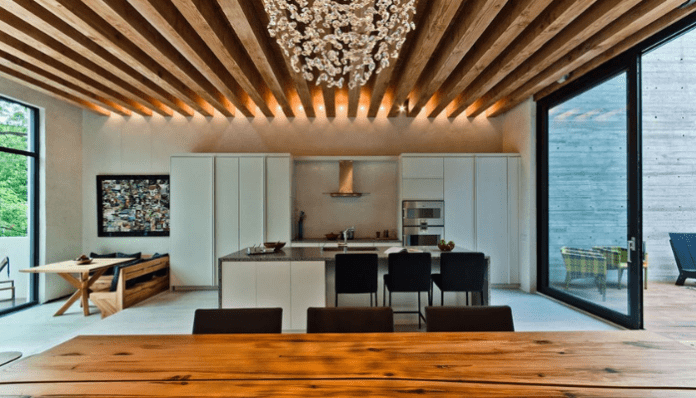Knotty pine paneling has made a comeback, especially for log homes and cabins. Today, it is used in many different style layouts in almost all home styles. It’s used for horizontal, vertical, diagonal, wainscoting, and unique patterns. You can be creative with 4”, 5”, 6”, and 8” wide paneling boards. Its ¾” thickness adds strength, stability, and character to any room.
When finishing knotty pine paneling, you must decide whether to do the job before or after installing it. Stain colors and a clear coat finish are typically applied with a cloth or brush and a brush respectively. It’s best to refrain from painting raw pine paneling or some resin may bleed out around the knots. Apply the finishes according to the manufacturer’s directions and you should have beautiful walls and ceilings.
Stain Before Or After Installing Pine Paneling
Before applying stains and finishes to the paneling, decide if you want to do the work before or after installing it. There are some pros and cons for each approach, including:
Before Installation
Pros Cons
Cover all edges and ends More time-consuming
Less chance for errors Labor intensive one board at a time
No over-stained corners
After Installation
Pros Cons
Faster first coat Can be messier if finish runs
Faster to sand dark spots
Faster second coat
Applying stains and clear coat finishes applies to pine trims and moldings as well as paneling. TIP: Try the stain on a piece of scrap paneling first to ensure it looks right, and then go forward. If you skip this step, you may be sorry you chose the wrong color. Stain can look different on wood than it does in the picture of the color on the container.
Favorite Stains For Pine Paneling
There are many variations of water-based and oil-based stains on the market. You may want to consider water-based stains because they emit fewer volatile organic compounds (VOCs) than oil-based stains. Sherwin Williams owns the Minwax brand that is affordable and easy to use. Sashco, Perma-Chink, and Minwax products have these benefits:
- Fast-drying and durable
- Penetrates well with rich stain color
- Easy to apply and seals wood well
- Minimal grain raising and tintable
- UV-resistant and uniform appearance
- Faster recoat times and cleans easily
Popular Clear Finishes For Pine Paneling
There are also many variations of water-based and oil-based clear coat finishes available. The popular ones include Sherwood Williams Minwax, Sashco, and Perma-Chink products that are available in satin, semi-gloss, and gloss finishes. They provide many benefits including:
- Easy to apply and fast-drying
- Durable with non-yellowing finish
- UV-resistant and uniform appearance
- Faster recoat times and cleans well
Note that some stains may not need a clear top coat and some stains have a finish coat mixed in with it.
Painting Knotty Pine Paneling
Knotty pine paneling should not be painted but should be stained with high-quality materials for beauty, toughness, and durability. Oil-based paints can start to peel and flake off over time. They keep wood paneling from “breathing” which is what you do not want. It can also make the knots bleed and run resin on white-painted wood that looks ugly.
Painting knotty pine wood can present problems with low-quality wood because the knots and the wood’s texture can be hard to cover. Water-based or acrylic paints create the same issues as oil-based paints. Although it’s a popular idea to paint knotty pine wood, we do not recommend it. The best finishing effects are achieved by using high-quality stains topped by two clear coats.

Tips On Finishing Knotty Pine Paneling
A little review of staining and finishing knotty pine can produce better results. Whether this is your first time staining or you have done it many times, follow these steps for a great job:
- Wipe each piece of wood with a cloth and lightly sand if necessary for good absorption
- If you sand the wood, wipe it off with a cloth
- Put on plastic gloves and stain with a soft cloth or a brush made for staining
- Although this has already been mentioned, try the stain on a scrap piece of paneling to ensure it looks right, then go forward
- Water-based stain looks great and is the preferred product today with no to low VOCs
- Oil-based stain has a strong odor and has a higher level of VOCs but looks great
- You may want to lightly sand the first clear coat, wipe clean, and apply a second coat
We hope these tips are useful for staining and finishing new raw knotty pine paneling. They do not apply to staining over wood that was previously stained with a clear coat applied on top or painted wood paneling.


